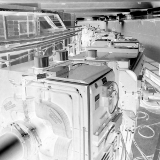Speaker
Zeudi Mazzotta
(Università degli Studi e INFN Milano (IT))
Description
The AEgIS experimental program on antimatter systems involves the formation of antihydrogen atoms for gravitational and CPT studies. One of the key ingredients of the AEgIS strategy for the synthesis of antihydrogen atoms is the creation and manipulation of Positronium (Ps) atoms laser excited in Rydberg states ($n>15$).
Ps is very interesting in its own right. Ps is indeed a truly "elementary atom", a purely leptonic system holding important possibilities for modern research topics such as Bose-Einstein condensation, higher-order QED corrections and laser cooling.
In AEgIS, Ps will be produced in bunched mode and its Rydberg excitation will be provided with a two laser pulse technique by passing through an $n=3$ intermediate level. Because excitation on Ps $n=3$ state has been never proposed before, in AEgIS several detection strategies are being studied in order to observe the first measurement ever on this interesting process.
Our main detection strategy involves the study of changes in the single shot gamma ray annihilation spectra of Ps. The method for $n=3$ excitation detection has been to photoionize excited Ps with an infrared laser and look for losses in the overall Ps lifetime curve. For Rydberg excitation, we detected losses in the short living Ps fraction, followed by gains in the long living section.
Authors
Fabrizio Castelli
(Università degli Studi e INFN Milano (IT))
Marco Giulio Giammarchi
(Infn Milano)
Simone Cialdi
(Università degli Studi e INFN Milano (IT))
Zeudi Mazzotta
(Università degli Studi e INFN Milano (IT))
